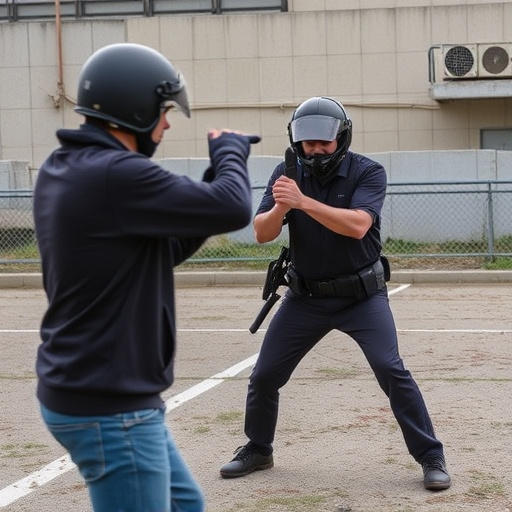Pepper spray, a personal defense tool using capsaicin from chili peppers, offers an escape window against aggressors. Safe handling and storage are crucial, focusing on preventing accidental activation. The Pepper Spray Eye Washing Procedure involves irrigating eyes with clean water for 15+ minutes post-use to alleviate discomfort and restore vision. Legal frameworks govern its sale, possession, and use, emphasizing proportional force and strict eye washing procedures to avoid legal issues.
“Uncover the power of civilian defense pepper spray—a non-lethal self-defense tool that can provide a critical advantage in intimidating potential attackers. Understanding its active ingredients, safety measures, and legal boundaries is essential for effective deployment. From knowing how to handle and store it correctly to mastering the precise eye washing procedure, this guide ensures users are prepared. Explore these crucial aspects, especially the intricate details of the Pepper Spray Eye Washing Procedure, to maximize its efficacy while navigating legal considerations.”
- Understanding Pepper Spray: Active Ingredients & Efficacy
- Safe Handling & Storage: Preventing Accidental Activation
- Eye Washing Procedure: Step-by-Step Guide for Effective Irritation Reduction
- Legal Considerations: Usage, Regulations, and Consent Issues
Understanding Pepper Spray: Active Ingredients & Efficacy
Pepper spray, a powerful personal defense tool, operates by targeting the eyes and respiratory system. The active ingredient, capsaicin, is derived from chili peppers and causes intense irritation. When sprayed, it temporarily disables an aggressor by reducing visibility and triggering a strong reaction that can last for several minutes.
The efficacy of pepper spray lies in its ability to create a momentary escape route. By causing tears and pain, it gives the user valuable time to retreat or seek help. The Pepper Spray Eye Washing Procedure is crucial; it involves irrigating the eyes with clean water for at least 15 minutes to alleviate discomfort and restore clear vision. Understanding these components ensures users can make informed decisions about self-defense and respond appropriately in potential threats.
Safe Handling & Storage: Preventing Accidental Activation
Safe handling and storage are paramount when it comes to civilian defense pepper spray products, especially to prevent accidental activation. Always keep your spray in a secure location, out of reach of children and unauthorized individuals. Store it in a cool, dry place, away from direct sunlight or extreme temperatures. Ensure the container is intact and not damaged before each use; any signs of tampering or physical harm should prompt immediate replacement.
When using the spray, follow recommended procedures to minimize risks. Never point the nozzle at anyone unless you intend to deploy it. In case of accidental activation, quickly activate the spray towards the ground to disperse the agent. Immediately after use, wash your eyes thoroughly with cold water for at least 15 minutes and seek medical attention if any discomfort or irritation persists. Proper eye washing procedure is crucial in mitigating the effects of pepper spray exposure.
Eye Washing Procedure: Step-by-Step Guide for Effective Irritation Reduction
In the event of pepper spray exposure, promptly initiating the eye-washing procedure is crucial for minimizing irritation and discomfort. Here’s a step-by-step guide to effectively irrigate eyes post-pepper spray contact. Firstly, immediately seek a safe location away from the source of the spray. Then, gently pour a large amount of clean, fresh water into one or both eyes, ensuring thorough coverage. Continue washing for at least 15 minutes, maintaining constant eye movement to help flush out the irritants. Use cool water if available, as it can provide additional relief.
Avoid using products like soap or contact lens solution, which may exacerbate irritation. Instead, focus on diluting and removing the pepper spray chemicals with copious amounts of water. After washing, maintain blinkless eye closure for several minutes to prevent re-exposure. If possible, seek medical attention, especially if symptoms persist or severe irritation occurs. Remember that a swift and thorough eye-washing procedure is instrumental in alleviating the effects of pepper spray exposure.
Legal Considerations: Usage, Regulations, and Consent Issues
The legal landscape surrounding civilian pepper spray products involves intricate considerations regarding usage, regulations, and consent issues. Each jurisdiction has its own set of rules governing the sale, possession, and application of such self-defense tools. One crucial aspect is understanding when and how pepper spray can be lawfully employed without infringing upon an individual’s rights or facing legal repercussions.
Usage guidelines often emphasize the need for proportionate force, especially in public spaces. The eye washing procedure, a critical component of pepper spray safety, must adhere to strict regulations to mitigate potential harm. Consent is another significant factor; using pepper spray against someone without their consent can lead to legal challenges and civil lawsuits. Awareness of local laws and proper training in the responsible use of pepper spray are essential for individuals considering self-defense options.
Pepper spray, a powerful self-defense tool, can be a civilian’s best friend in potentially dangerous situations. By understanding its active ingredients, safe handling practices, and legal boundaries, individuals can effectively utilize pepper spray for personal protection. Moreover, learning the correct eye washing procedure is crucial to mitigate the effects of exposure and ensure swift recovery. Remember that knowledge and preparation are key to navigating potential threats, empowering civilians to defend themselves confidently.
